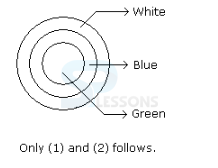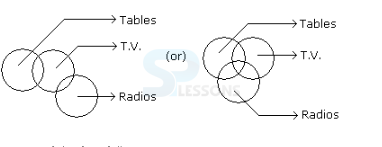 Introduction
Introduction
- The RRC Group D Reasoning section in Computer Based Test (CBT) contains 30 questions with 30 Maximum Marks (Each question carry 1 Mark).
- There will be negative marking and 1/3 marks shall be deducted for each wrong answer.
 Pattern
Pattern
RRC Group D Level-1 - Computer Based Test (CBT) Pattern:
- The examination duration and number of questions for CBT are indicated below:
Exam Duration in Minutes No of Questions (each of 1 mark) from Total No of Questions General Science Mathematics General Intelligence and Reasoning General Awareness and Current Affairs 90 25 25 30 20 100 - The examination duration will be 120 Minutes for eligible PwBD candidates accompanied with Scribe.
- The section wise distribution given in the above table is only indicative and there may be some variation in the actual question paper.
 Syllabus
Syllabus
[Click Here] for RRC Group D Reasoning Syllabus.
 Samples
Samples
Analogies
Direction (1 - 5): A good way to figure out the relationship in a given question is to make up a sentence that describes the relationship between the first two words. Then, try to use the same sentence to find out which of the answer choices completes the same relationship with the third word.
1. Odometer is to mileage as compass is to
- A. speed
B. hiking
C. needle
D. direction
- A. winter
B. bear
C. dream
D. sleep
- A. novel
B. glass
C. cover
D. page
- A. dish
B. soup
C. spoon
D. food
- A. gallon
B. ounce
C. milk
D. liquid
- A. 14
B. 15
C. 21
D. 23
- A. 26
B. 28
C. 30
D. 32
- A. 7
B. 10
C. 14
D. 15
- A. 9
B. 29
C. 32
D. 34
- A. 15
B. 14
C. 13
D. 12
- A. EXOTLC
B. CXOTIE
C. COXITE
D. CITOXE
E. EOXITC
- A. VXEEIVV
B. VXFFHVV
C. VYEEHVV
D. VYEFIVV
E. None of these.
- A. NCPQJG
B. NCQPJG
C. RCPQJK
D. RCTQNG
E. None of these.
- A. TLATLATLA
B. MNUMNUMNU
C. IATIATIAT
D. ALDALDALD
E. None of these.
- A. EDRIRL
B. DCQHQK
C. ESJFME
D. FYOBOC
E. DEQJQM
- A. + and -
B. - and ÷
C. + and x
D. + and ÷
- A. 6 - 3 x 2 = 9
B. 3 - 6 x 8 = 10
C. 6 x 3 - 4 = 15
D. 3 x 6 - 4 = 33
- A. + and -
B. - and ÷
C. + and x
D. + and ÷
- A. 6 - 8 ÷ 4 = - 1
B. 8 - 6 ÷ 4 = 1
C. 4 ÷ 8 - 2 = 6
D. 4 - 8 ÷ 6 = 2
- A. 5 x 4 + 20 = 40
B. 5 x 4 + 20 = 85
C. 5 x 4 + 20 = 104
D. 5 x 4 + 20 = 95
- A. Son
B. Brother
C. Cousin
D. Brother-in-law
- A. Daughter
B. Son
C. Nephew
D. Cannot be decided
- A. Mother-in-law
B. Aunt
C. Wife
D. None of these
- A. P x Q % R + S - T
B. P x Q % R - T + S
C. P x Q % R + T - S
D. P x Q % R + S + T
- A. Sister
B. Grandmother
C. Mother-in-law
D. Mother
- A. Only (2) and (4)
B. Only (1) and (3)
C. Only (3) and (4)
D. Only (3)
E. All the four
- A. Only (1) and (2)
B. Only (1) and (3)
C. Only (1) and (4)
D. Only (2) and (4)
- A. Only (4)
B. Only (2)
C. Only (3)
D. Only (1)
E. Only (1) and (3)
- A. Only (1) and (4)
B. Only (3) and (4)
C. Only (2) and (4)
D. Only (1) and (2)
E. Only (1) and (3)
- A. Only (2) and (4)
B. Only (1) and (3)
C. Only (4)
D. Only (1) and (4)
E. None of the four.
- A. 17
B. 5
C. 10
D. 30
- A. 22
B. 8
C. 3
D. 30
- A. 5
B. 8
C. 25
D. 16
- A. 25
B. 17
C. 5
D. 10
- A. 10
B. 17
C. 30
D. 15
- A. if the data in statement I alone are sufficient to answer the question;
B. if the data in statement II alone are sufficient to answer the question;
C. if the data either in I or II alone are sufficient to answer the question;
D. if the data even in both the statement together are not sufficient to answer the question;
E. if the data in both the statements together are needed.
- A. if the data in statement I alone are sufficient to answer the question;
B. if the data in statement II alone are sufficient to answer the question;
C. if the data either in I or II alone are sufficient to answer the question;
D. if the data even in both the statement together are not sufficient to answer the question;
E. if the data in both the statements together are needed.
- A. if the data in statement I alone are sufficient to answer the question;
B. if the data in statement II alone are sufficient to answer the question;
C. if the data either in I or II alone are sufficient to answer the question;
D. if the data even in both the statement together are not sufficient to answer the question;
E. if the data in both the statements together are needed.
- A. if the data in statement I alone are sufficient to answer the question;
B. if the data in statement II alone are sufficient to answer the question;
C. if the data either in I or II alone are sufficient to answer the question;
D. if the data even in both the statements together are not sufficient to answer the question;
E. if the data in both the statements together are needed.
- A. if the data in statement I alone are sufficient to answer the question;
B. if the data in statement II alone are sufficient to answer the question;
C. if the data either in I or II alone are sufficient to answer the question;
D. if the data even in both the statements together are not sufficient to answer the question;
E. if the data in both the statements together are needed.
- A. if the candidate is to be selected.
B. if the case is to be referred to the President.
C. if the case is to be referred to the Director.
D. if the case is to be referred to the DGM.
E. if the candidate is not to be selected.
- A. if the candidate is to be selected.
- A. if the candidate is to be selected.
B. if the case is to be referred to the President.
C. if the case is to be referred to the Director.
D. if the case is to be referred to the DGM.
E. if the candidate is not to be selected.
- A. if the candidate is to be selected.
B. if the case is to be referred to the President.
C. if the case is to be referred to the Director.
D. if the case is to be referred to the DGM.
E. if the candidate is not to be selected.
- A. if the candidate is to be selected.
B. if the case is to be referred to the President.
C. if the case is to be referred to the Director.
D. if the case is to be referred to the DGM.
E. if the candidate is not to be selected.
- 1
- 2
- 3
- 4
- 5
- A. Suvarna
B. Tara
C. Uma
D. Vibha
- A. 36
B. 72
C. 16
D. None of these
- A. A is at the first place
B. A is at the second place
C. A is at the third place
D. A is at the fourth place
- A. The first place only
B. The third place only
C. The first and third place only
D. Any of the places
- A. C is not at the first place
B. A is at third place C.
D is at the first place
D. C is at the first place
- A. 326
B. 248
C. 392
D. 414
- A. 84
B. 63
C. 98
D. 91
E. 65
- A. 20-10
B. 15-12
C. 45-27
D. 30-18
- A. 27
B. 39
C. 42
D. 48
E. 24
- A. 7324
B. 9611
C. 1754
D. 2690
- A. East
B. South
C. West
D. Data is inadequate
- A. South-East
B. North-West
C. South
D. West
- A. North
B. North-West
C. North-East
D. East
- A. North
B. South
C. East
D. West
- A. North
B. North-west
C. East
D. North-east
- A. The only argument I is strong
B. Only argument II is strong
C. Either I or II is strong
D. Neither I nor II is strong
E. Both I and II are strong
- A. The only argument I is strong
B. Only argument II is strong
C. Either I or II is strong
D. Neither I nor II is strong
E. Both I and II are strong
- A. The only argument I is strong
B. Only argument II is strong
C. Either I or II is strong
D. Neither I nor II is strong
E. Both I and II are strong
- A. The only argument I is strong
B. Only argument II is strong
C. Either I or II is strong
D. Neither I nor II is strong
E. Both I and II are strong
- A. The only argument I is strong
B. Only argument II is strong
C. Either I or II is strong
D. Neither I nor II is strong
E. Both I and II are strong









